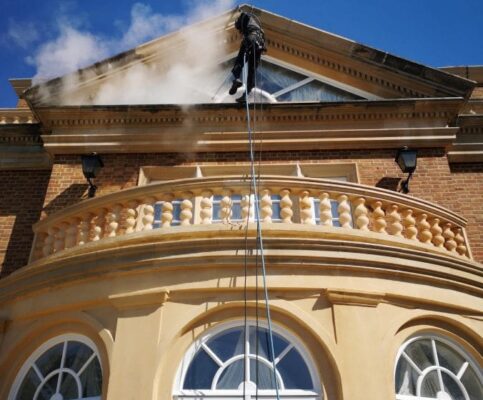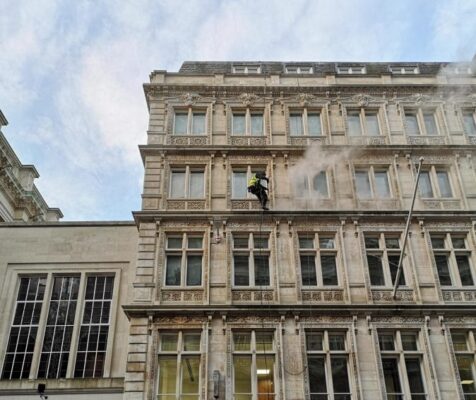View More SErvices Contact Us
Facade Cleaning in Leamouth
Cleaning building facades from top to bottom, no matter how tall your building.
Natural stone facade cleaning in Leamouth can be accessed and cleaned efficiently and effectively by using rope access methods. Using this method, the need for local authority permits is totally eradicated, allowing works to proceed immediately. Using professional stone cleaning equipment we can roll back the years to make your building look like new.
Brick cleaning
Brick buildings become dirty as much as any other building. We will not only clean away the dirt and grime, we can revitalise the colour. Using a range of bio-degradable chemicals, we can restore the colour of red or yellow bricks.
Contact UsGlass facade cleaning in Leamouth
Glass facade cleaning in Leamouth takes place by abseilers using traditional window cleaning tools. External windows, internal atriums, after builders cleaning or regular maintenance cleans, our abseilers are experienced in all manner of glass cleaning.
Contact UsAluminium cladding cleaning
Aluminium cladding in Leamouth can become extremely dirty over time. Warehouses that have many lorries coming and going will become soiled with traffic film. Using our steam cleaning systems, this grime is washed away leaving a lasting first impression for your visitors.
Contact UsOur services
Rope Access Facade Cleaning Services for Leamouth And Surrounding Counties

Residential property Stone Facade Cleaning
Façade cleaning at this residential property in Leamouth, which was not of any great height but, had no access for other forms of access equipment. Abseiling was the solution and the results were outstanding.

Stone Steam Cleaning in London
This beautiful natural stone building was looking tired from the day to day London traffic. Rope access was seen as the most cost-effective method of access.

Concrete Facade Cleaning in Leamouth
This car park in Essex was filthy. It hadn’t been cleaned, ever. As the access to three elevations was extremely tight, abseiling was the only method that could achieve the results.

Facade Cleaning in Leamouth
A new acquisition for our client needed a freshen up. Out of hours abseiling was the best way to clean this building in the heart of the City of London.
Brick colour restoration
Before colour restoration
This client requested a test patch before assigning us the job of cleaning their building. We carried this out with amazing results.
After colour restoration
These are the pictures of the test patch that we sent to the client. Her reaction was simply ‘WOW’. That’s the perfect response for us.
Torik Stone Cleaning System Features
150 degrees centigrade steam cleaning power
Provides a continues flow of superheated water to penetrate stone and deep clean, removing organic growth & ground in dirt.
We use Tensid (uk) Ltd
Providers of specialist cleaning equipment and specialist cleaning chemicals to professionals.
Get In Touch
Fill in the form below and we’ll be in touch within 24hrs of receiving your message.
Facts About Leamouth
Leamouth History
Orchard Place was the name of its manor house on the spit; this had become an eponymous public house from 1800–60. When the docks were constructed, the area became isolated, with the only access via the dock road, from Poplar. Residents were engaged at the glassworks, the iron and engineering works, or the Samuda Brothers, Orchard House Yard and Thames Iron Works shipyards.
When the Thames Plate Glass Works closed in 1874, many of the hands – who had migrated to the area from Tyneside and St Helens in the 1840s – followed the glassworks to New Albany, Indiana. To house the workers, there were about 100 small two-storied cottages – built from the 1820s and condemned in 1935.
General Info
Leamouth is a mixed-use development and historically a wharf in the Port of London in Blackwall. It lies on the west side of the confluence of the Bow Creek stretch of the Lea, and the River Thames. The neighbourhood consists of two small peninsulas, separated from the rest of Poplar by both the river and the remaining part of the East India Docks and became more seen as part of Canning Town.
Its northern peninsula lies in a hairpin meander and is named Goodluck Hope after one of the adjacent reaches of the Lea, while the other is known as Orchard Place. The area was long referred to locally as Bog Island, due to its inaccessibility and propensity to flood. However the building of the Thames Barrier and the artificial raising of the more vulnerable riverside land. Meaning the nickname refers to a now much-reduced threat.



